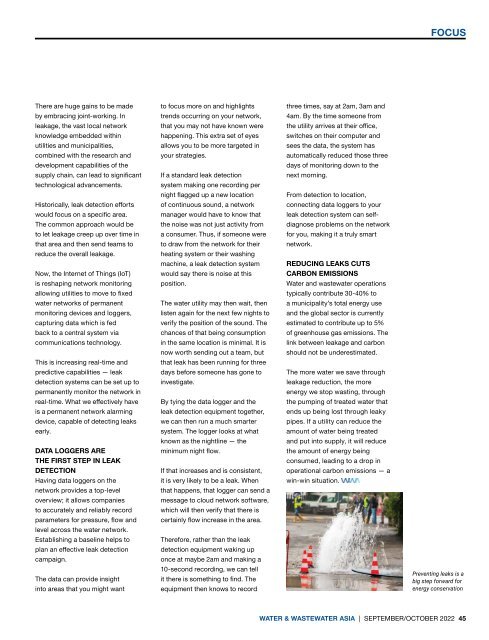Water & Wastewater Asia September/October 2022
Water & Wastewater Asia is an expert source of industry information, cementing its position as an indispensable tool for trade professionals in the water and wastewater industry. As the most reliable publication in the region, industry experts turn this premium journal for credible journalism and exclusive insight provided by fellow industry professionals. Water & Wastewater Asia incorporates the official newsletter of the Singapore Water Association (SWA).
Water & Wastewater Asia is an expert source of industry information, cementing its position as an indispensable tool for trade professionals in the water and wastewater industry. As the most reliable publication in the region, industry experts turn this premium journal for credible journalism and exclusive insight provided by fellow industry professionals. Water & Wastewater Asia incorporates the official newsletter of the Singapore Water Association (SWA).
Create successful ePaper yourself
Turn your PDF publications into a flip-book with our unique Google optimized e-Paper software.
FOCUS<br />
There are huge gains to be made<br />
by embracing joint-working. In<br />
leakage, the vast local network<br />
knowledge embedded within<br />
utilities and municipalities,<br />
combined with the research and<br />
development capabilities of the<br />
supply chain, can lead to significant<br />
technological advancements.<br />
Historically, leak detection efforts<br />
would focus on a specific area.<br />
The common approach would be<br />
to let leakage creep up over time in<br />
that area and then send teams to<br />
reduce the overall leakage.<br />
Now, the Internet of Things (IoT)<br />
is reshaping network monitoring<br />
allowing utilities to move to fixed<br />
water networks of permanent<br />
monitoring devices and loggers,<br />
capturing data which is fed<br />
back to a central system via<br />
communications technology.<br />
This is increasing real-time and<br />
predictive capabilities — leak<br />
detection systems can be set up to<br />
permanently monitor the network in<br />
real-time. What we effectively have<br />
is a permanent network alarming<br />
device, capable of detecting leaks<br />
early.<br />
DATA LOGGERS ARE<br />
THE FIRST STEP IN LEAK<br />
DETECTION<br />
Having data loggers on the<br />
network provides a top-level<br />
overview; it allows companies<br />
to accurately and reliably record<br />
parameters for pressure, flow and<br />
level across the water network.<br />
Establishing a baseline helps to<br />
plan an effective leak detection<br />
campaign.<br />
The data can provide insight<br />
into areas that you might want<br />
to focus more on and highlights<br />
trends occurring on your network,<br />
that you may not have known were<br />
happening. This extra set of eyes<br />
allows you to be more targeted in<br />
your strategies.<br />
If a standard leak detection<br />
system making one recording per<br />
night flagged up a new location<br />
of continuous sound, a network<br />
manager would have to know that<br />
the noise was not just activity from<br />
a consumer. Thus, if someone were<br />
to draw from the network for their<br />
heating system or their washing<br />
machine, a leak detection system<br />
would say there is noise at this<br />
position.<br />
The water utility may then wait, then<br />
listen again for the next few nights to<br />
verify the position of the sound. The<br />
chances of that being consumption<br />
in the same location is minimal. It is<br />
now worth sending out a team, but<br />
that leak has been running for three<br />
days before someone has gone to<br />
investigate.<br />
By tying the data logger and the<br />
leak detection equipment together,<br />
we can then run a much smarter<br />
system. The logger looks at what<br />
known as the nightline — the<br />
minimum night flow.<br />
If that increases and is consistent,<br />
it is very likely to be a leak. When<br />
that happens, that logger can send a<br />
message to cloud network software,<br />
which will then verify that there is<br />
certainly flow increase in the area.<br />
Therefore, rather than the leak<br />
detection equipment waking up<br />
once at maybe 2am and making a<br />
10-second recording, we can tell<br />
it there is something to find. The<br />
equipment then knows to record<br />
three times, say at 2am, 3am and<br />
4am. By the time someone from<br />
the utility arrives at their office,<br />
switches on their computer and<br />
sees the data, the system has<br />
automatically reduced those three<br />
days of monitoring down to the<br />
next morning.<br />
From detection to location,<br />
connecting data loggers to your<br />
leak detection system can selfdiagnose<br />
problems on the network<br />
for you, making it a truly smart<br />
network.<br />
REDUCING LEAKS CUTS<br />
CARBON EMISSIONS<br />
<strong>Water</strong> and wastewater operations<br />
typically contribute 30-40% to<br />
a municipality’s total energy use<br />
and the global sector is currently<br />
estimated to contribute up to 5%<br />
of greenhouse gas emissions. The<br />
link between leakage and carbon<br />
should not be underestimated.<br />
The more water we save through<br />
leakage reduction, the more<br />
energy we stop wasting, through<br />
the pumping of treated water that<br />
ends up being lost through leaky<br />
pipes. If a utility can reduce the<br />
amount of water being treated<br />
and put into supply, it will reduce<br />
the amount of energy being<br />
consumed, leading to a drop in<br />
operational carbon emissions — a<br />
win-win situation.<br />
Preventing leaks is a<br />
big step forward for<br />
energy conservation<br />
WATER & WASTEWATER ASIA | SEPTEMBER/OCTOBER <strong>2022</strong> 45


















